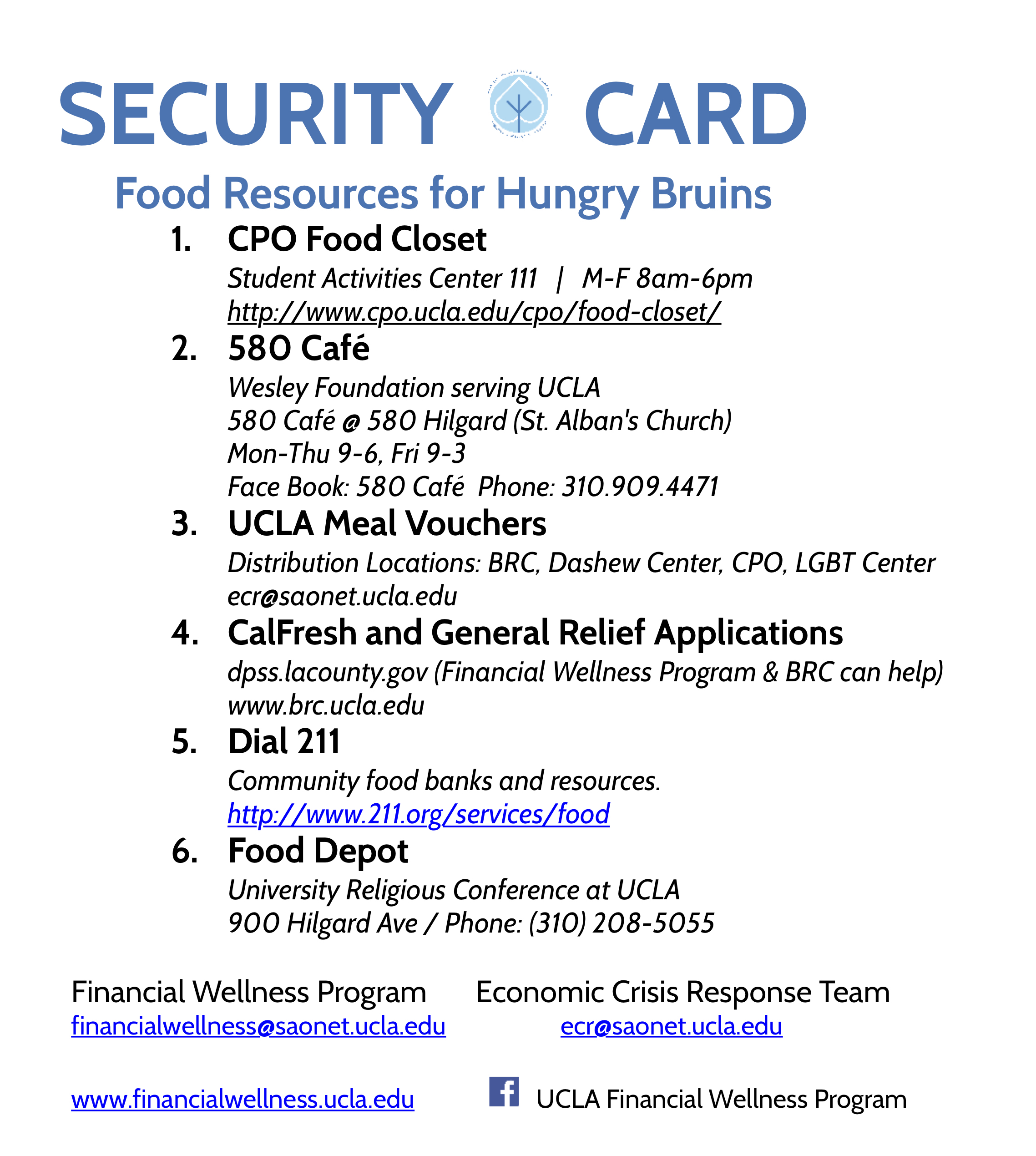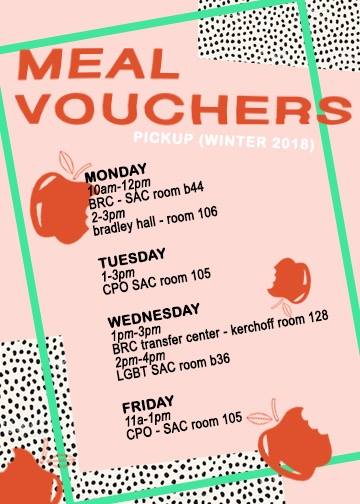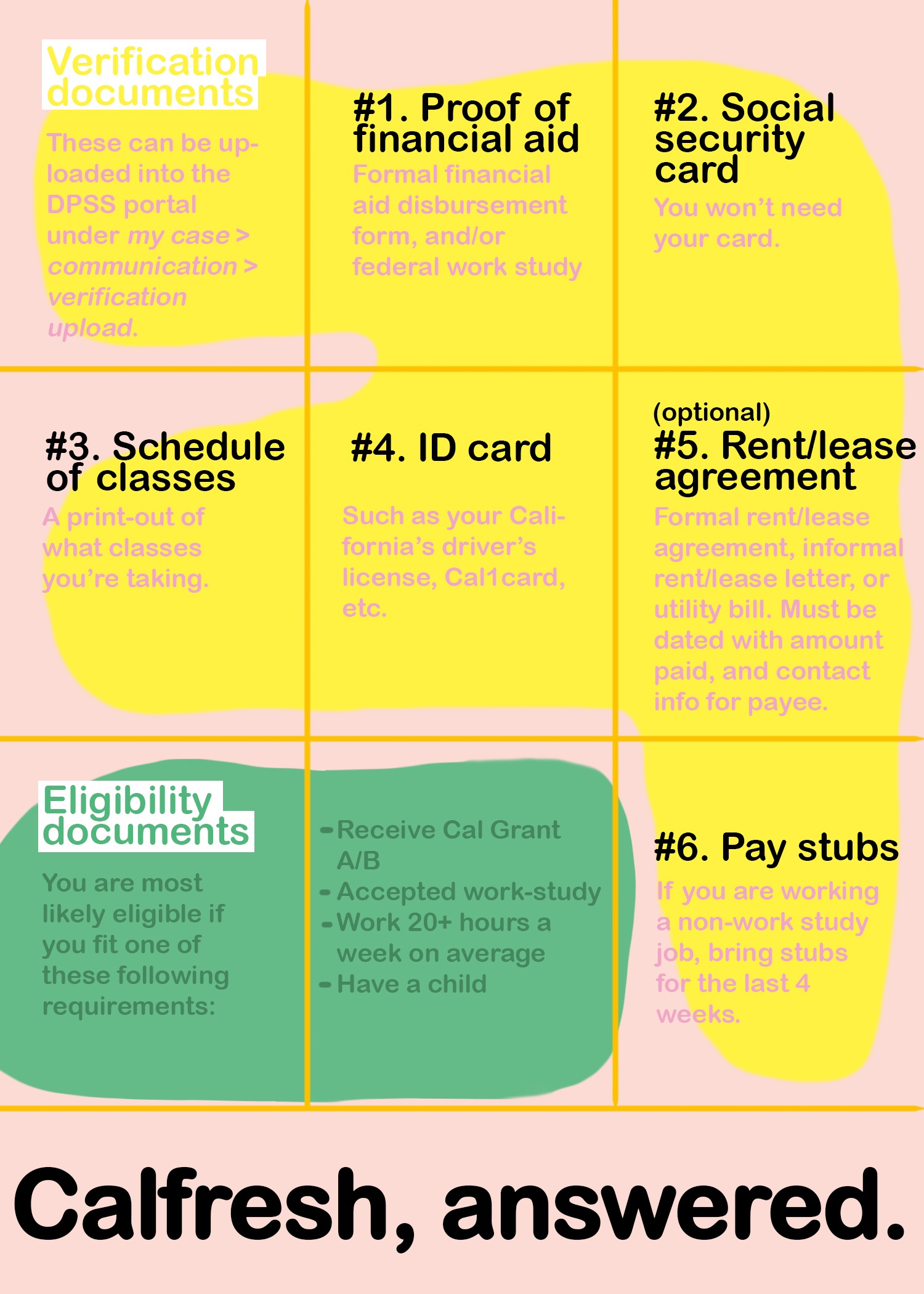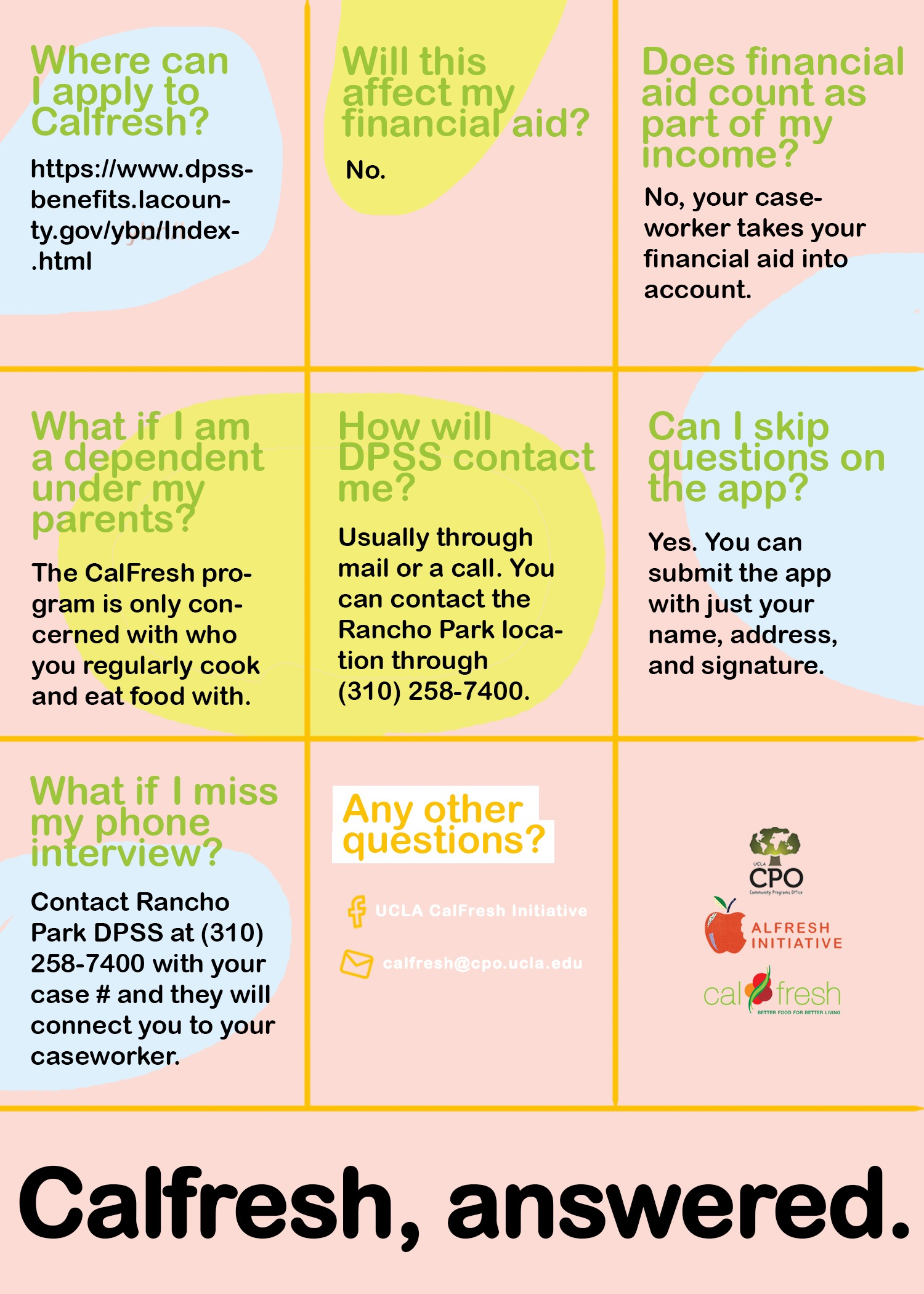Faculty and Staff
Click here to add your own text
College students are hungry. For some time, the accepted explanation for student hunger has been “it’s just part of the typical, struggling college-student experience.” However, this narrative that college students are supposed to survive on the cup-of-noodles diet undermines the reality that many students do not have consistent access to nutritious food, go to bed hungry some nights, and/or have to choose between paying rent and buying groceries each month. According to the University of California’s 2017 Global Food Initiative report, 48% of UC undergraduate and 25% of graduate students “experience some level of food insecurity.” Given these alarming statistics, it is important that universities not only offer food security resources to students, but also increase awareness of and access to these resources in a destigmatized environment. So where are these resources at UCLA? And do students know about UCLA’s rich basic needs landscape? That’s where the CalFresh Initiative at UCLA comes in.
CalFresh 101
So what is CalFresh? CalFresh is California’s version of SNAP (Supplemental Nutrition Assistance Program), a federally-funded food assistance program, colloquially known as food stamps. Thanks to recent legislation, parts of CalFresh have been tailored to meet the specific needs and experiences of college students, allowing eligible students to receive up to $192/month for groceries. Most students qualify for CalFresh if they have work study, receive CalGrant A or B, have a child, or work over 20 hours per week outside of UCLA. After completing the application process with a Department of Public Social Services (DPSS) eligibility worker and receiving approval, students receive an EBT (electronic benefits transfer) card, which is re-loaded monthly and functions as a debit card in participating grocery stores (Ralphs, Target, Trader Joe’s, and Whole Foods all accept EBT!). Given the benefits of CalFresh and the large percentage of students who are food insecure, it is problematic that only 2% of UCLA students who are eligible for CalFresh are enrolled (according to data provided by DPSS). The CalFresh Initiative at UCLA aims to increase awareness of and enrollment in CalFresh among students.
Keeping UCLA CalFRESH
The CalFresh Initiative at UCLA was brought to campus last year by UCLA’s Global Food Initiative Fellows in order to streamline the CalFresh application process for students. In addition to our daily outreach, the CalFresh Initiative at UCLA hosts quarterly CalFresh enrollment days, bringing several DPSS workers to campus in an effort to boost enrollment and make the application process more accessible for students. This quarter, we partnered with other organizations on campus to expand from just a CalFresh enrollment day to a broader Basic Needs Resource Fair, where students could learn about the landscape of on-campus resources — and pick up free food bundles! Some of the organizations tabling at the fair were SWC Bruin Necessities, BruinDine, Imperfect Produce, Financial Wellness Peers, California Lifeline with Cafe 580 (free cellphones and cellphone plans), Swipe Out Hunger, and the USAC External Vice President office who were phone banking for SB 900, which would grant more CalFresh dollars to fresh produce.
Over the past three enrollment fairs, about 300 UCLA students have enrolled in CalFresh. Since starting the CalFresh Initiative at UCLA last year, we have also helped about 400 students apply for CalFresh via email. We are thrilled to share that starting March 5th of this quarter, for the first time ever, we will have a CalFresh eligibility worker from DPSS on campus in the Student Activities Center (SAC) every first and third Monday of the month to enroll students in CalFresh through private appointments. Although anyone can apply for CalFresh anytime online, applying through an in-person appointment is a much simpler and more efficient process. Fill out this pre-screening tool to find out if you are eligible for CalFresh and to see what verification documents you need to apply. Then sign up here for an on-campus CalFresh enrollment appointment. Check out our infographics below for more details.
Beyond the basic needs infrastructure and resources that UCLA offers, CalFresh enrollment provides a sustainable solution for food insecure students that is not limited by university hours and buildings. CalFresh recipients can comfortably choose what they would like to eat from a grocery store, and are not limited to buying cheap, and often unhealthy, food.
Our team at the CalFresh Initiative is working towards the day when CalFresh is a destigmatized conversation, and when the most important worry on students’ minds is their next midterm and not their next meal.
Some important, readily available food security resources on or near campus are:


Contact the CalFresh Initiative at UCLA at uclacalfresh@gmail.com.
Like us on Facebook at UCLA CalFresh Initiative.
Shelly Dieu is the Global Food Initiative Fellow leading the CalFresh Initiative at UCLA. She conducts research with the School of Public Health and is a third-year Geography/Environmental Studies major and Geographic Information Systems and Food Studies minors.
Sienna Rohrer is the Outreach Coordinator at the CalFresh Initiative at UCLA. She is a second-year Geography/Environmental Studies major and likely Geographic Information Systems and Food Studies minors.


UCLA Dining continually strives to provide delicious, nutritious, and sustainable dishes for students within its dining halls. As part of this effort, Dining has begun to incorporate “bycatch fish” caught in overpopulated areas in order to add a larger variety to the menu, and to help the environment as well.
Shrimp, salmon, and tuna are some of the most popular fish in the United States, which makes them the target population for many companies. As a result, most other types of fish that are caught while fishing will be released back into the ocean, often injured or dead, which results in a large waste of food both for humans and wildlife. These unwanted fish are referred to as “bycatch fish.”
Dining, recognizing this issue, has begun to work with their regular suppliers in order to use bycatch fish. Al Ferrone, the Senior Director of Dining says their goal is to “identify fish that are underutilized and caught unintentionally” in order to use them, rather than fishermen “throwing them back in the ocean and wasting them.”
Specifically, Ferrone says Dining is looking at fish like lionfish, which, due to overpopulation, have been eating all of the coral off of the Gulf Coast; as well as catfish which have, by a similar issue, been eating all of the crustaceans off the coast of Maryland. While Dining typically likes to source their ingredients locally, when it comes to ingredients like the fish above, they don’t mind getting food from around the United States as long as it’s helping the environment.
Adding a variety of fish to dishes isn’t just good news for the environment, but for students as well. Fish contain protein and fatty acids needed to keep your body healthy and are correlated with improved heart health and long-term overall health benefits.
To catch these fresh fish dishes, students should keep an eye out on the Dining menus. The fish will fluctuate depending on when they’re caught, but students can expect more fish in a larger variety within their Dining halls. In addition, UCLA can look forward to a growth in variety of dishes offered as Dining continues to look for delicious and healthy products that help the environment.
Photo: Depicted above is a lionfish, one of the many fish Dining plans to use in their new dishes.
Aurora Finley is an undergraduate student at UCLA majoring in English. Along with blogging for the UCLA Healthy Campus Initiative, she is the Sexperts Executive Director for the 2017-18 academic year. She is also a regular volunteer for UCLA’s Habitat for Humanity chapter and blogs for the online UCLA Odyssey community.
This Fall UCLA hosted a variety of nutrition offerings for students to take advantage of. Provided by a variety of campus partners, these events and workshops helped to bring attention to nutrition not just on campus, but in the individual lives of students.
Students who live on the Hill could attend workshops to learn how to navigate the dining halls, including tips of when to eat and how to balance a meal amongst the variety of great food the halls offer. FITTED Eats, a program aimed at promoting holistic health through free fitness and nutrition workshops and services, also hosts meetings every Tuesday to discuss wellness tips centered around food and nutrition. Student groups can also request nutrition workshops through email.
Jui Sarwate, an undergraduate who regularly takes part in FITTED events, said: “Participating in FITTED Eats has made it possible for me to have access to nutritional education which I wouldn’t have known about otherwise.”
Some of the workshops and events offered focused more on body image and food, such as a screening of Killing Us Softly, a film about women’s bodies in the media, hosted by the Student Wellness Commission’s Body Image Task Force. There were also multi-week workshops including “Make Peace with Fitness and Food” and “Body Image and the Media.”
One undergraduate, Alyssa Tabula, went to the “Body Image and Media” workshop series and said the workshop “taught [her] how to encourage those around [her] to be sensitive to the use of fat talk, or language that encourages the thin ideal.” Rather, she says that it’s important to promote a healthy ideal, which “begins with educating yourself with workshops like these and changing the conversation with yourself and those around you.”
Continuing resources being offered are the Dietitian Office Hours, where students can ask Kaitlin Reid, MPH, RDN, CLEC and Eve Lahijani, MS, RD any non-clinical questions about nutrition, or even just general well-being. These office hours are meant to be a casual way for students to get information from experts on nutrition, body image, and well-being.
“Any time I can help a student better understand nutrition and their relationship with food and their body, I consider that a success- whether it be one student or 50 at a time,” said Reid, a dietitian dedicated to furthering the nutrition offerings at UCLA.
All of these resources will be offered again in during Winter Quarter. While dates have yet to be determined, the information will be posted on instagram once it’s decided.
Any students interested in learning more about food and nutrition can apply to the Food Studies Undergraduate Minor or the Food Studies Graduate Certificate. You can also join the Healthy Campus Initiative for the next EatWell pod meeting on January 18th, from 10-11am in TLSB 5100. Or, consider joining a variety of student groups who focus on nutrition, like the Public Health Nutrition Club, and body image, like the Body Image Task Force.
Aurora Finley is an undergraduate student at UCLA majoring in English. Along with blogging for the UCLA Healthy Campus Initiative, she is the Sexperts Executive Director for the 2017-18 academic year. She is also a regular volunteer for UCLA’s Habitat for Humanity chapter and blogs for the online UCLA Odyssey community.